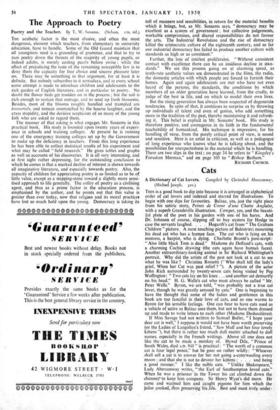The Approach to Poetry
Poetry and the Teacher. By T. W. Sussams. (Nelson. 12s. 6d.)
THE aesthetic factor is the most elusive, and often the most dangerous, element which teachers, from elementary to university education, have to handle. Some of the Old Guard maintain that all youngsters need is a grounding of grammar, and that to try to ram poetry down the throats of the majority of young pupils, or indeed adults, is merely casting pearls before swine ; while the effect of prejudicing the taste of the remaining susceptible few is to deny them the capacity for free choice and sincere pleasure later on. There may be something in that argument, for at least it is definite. But nobody subscribes to it nowadays, and in every school some attempt is made to introduce children and adolescents to the rich garden of English literature, and in particular to poetry. No doubt the flower beds get trodden on in the process ; but the soil is rich enough to sustain that outrage, and to send up fresh blossoms. Besides, most of the blooms roughly handled and trampled are inunortels, and remain unsmutched by the hoarse laughter, and the crass stupidity, and the derisive scepticism of so many of the young folk who are asked to regard them.
The manner of that asking is what engages Mr. Sussams in this practical book. His study is founded upon twenty years of experi- ence in schools and training colleges. At present he is running one of the emergency training colleges set up by the Government to make up the deficiency in teachers. From this long experience he has been able to collect statistical results of his experiment and what may be called "field research." He gives tables and graphs as well as accounts of his discoveries. It is all very interesting, and at first sight rather depressing, for the outstanding conclusion to which he comes is that a marked decline of interest is shown towards all imaginative literature, and especially towards poetry. Also, the capacity of children for appreciating poetry is so limited as to be of little value, except as a stepping-stone toward a slightly more sensi- tised approach to life generally. The utility of poetry as a civilising agent, and thus as a prime factor in the education process, is emphasised by the author, and he points out that this value is greater than ever today, now that religion and its moral practices have lost so much hold upon the young. Democracy is taking its toll of manners and sensibilities, in return for the material benefits which it brings, but, as Mr. Sussams says, "democracy may be excellent as a system of government ; but collective judgements, workable compromises, and shared responsibilities do not favour the arts. The Industrial Revolution and the rise of democracy killed the aristocratic culture of the eighteenth century, and so far our industrial democracy has failed to produce another culture with standards as high or as consistent."
Further, the loss of inteTest proliferates. "Without consistent contact with excellence there can be an insidious decline in stan- dards." We see this process going on at alarming speed, as tenth-rate aesthetic values are demonstrated in the films, the radio, the domestic articles with which people are forced to furnish their homes. Again and again adolescents are met who have not even heard of the persons, the standards, the conditions by which members of an older generation have learned, from the cradle, to judge of the best in life, and on which to model their own lives.
But the rising generation has always been suspected of degenerate tendencies. In spite of that, it continues to surprise us by throwing up individuals of talent and even of genius, who add something more to the tradition of the Past, thereby maintaining it and refresh- ing it. This belief is explicit in Mr. Sussams' book. His study is therefore positive, and courageous in its faith in the fundamental teachability of humankind. His technique is impressive, for his handling of verse, from the purely critical point of view, is sound and sensitive. Here is an artist in criticism, as well as a pedagogue of long experience who knows what he is talking about, and the possibilities for unexpectedness in the material which he is handling. There are two slips in the text ; on page 34 he refers to "Kingsley's Forsaken Merman," and on page 103 to "Bishop Barham."
RICHARD CHURCH.






























 Previous page
Previous page